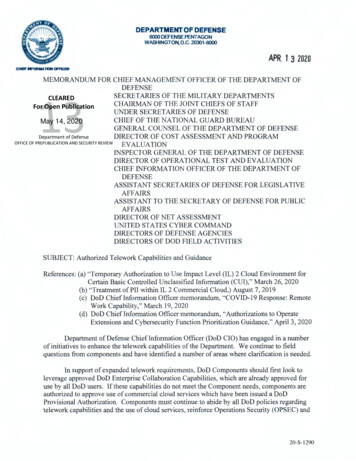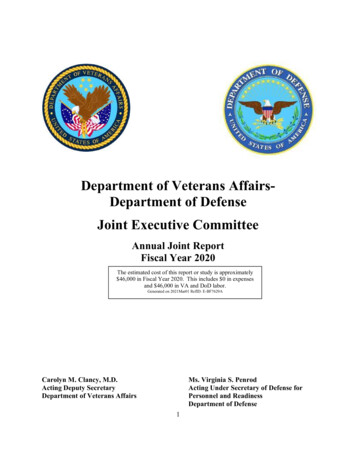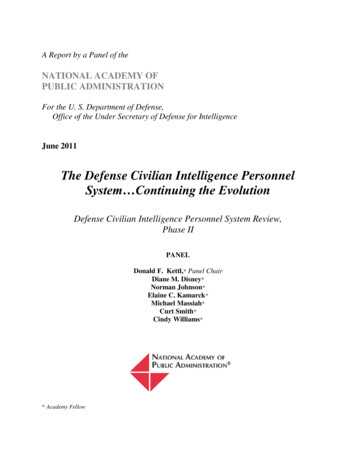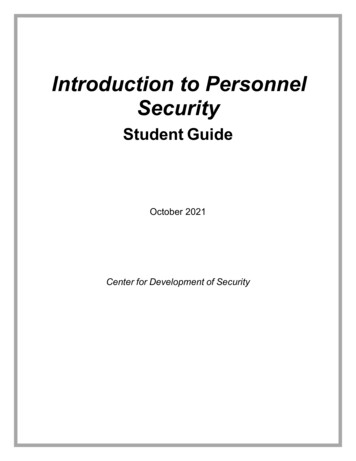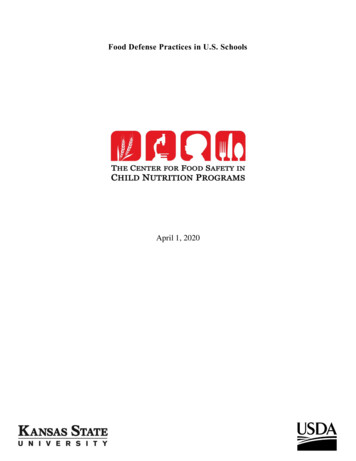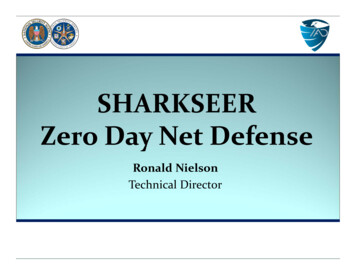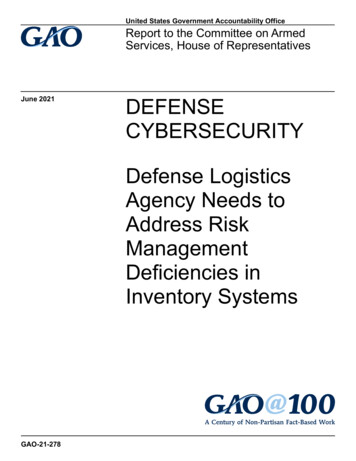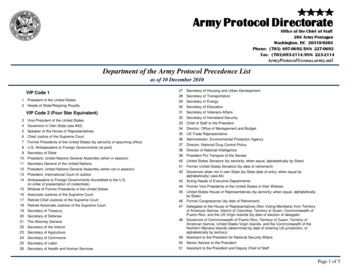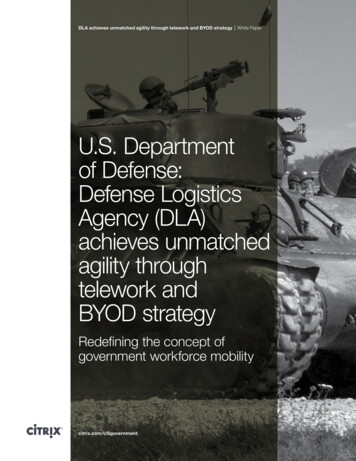
Transcription
DLA achieves unmatched agility through telework and BYOD strategyWhite PaperU.S. Departmentof Defense:Defense LogisticsAgency (DLA)achieves unmatchedagility throughtelework andBYOD strategyRedefining the concept ofgovernment workforce mobilitycitrix.com/USgovernment
DLA achieves unmatched agility through telework and BYOD strategyWhite Paper“ At DLA, work is defined as an activity—not a location.”—Mr. Joshua Lashbrook, Chief Technology Officer, Defense Logistics AgencyIntroductionThe Defense Logistics Agency (DLA), an agency within the U.S. Department ofDefense, has always taken a strategic approach to using information technology (IT)for achieving its mission. However, its goal of becoming a high-performing agencyran head-on into shrinking budgets and sequestration constraints. To improveits agility in the event of an emergency or catastrophic events, DLA adopted atelework, and later, a Home Use computing program. As the Agency’s CTO, Mr.Lashbrook establishes the technical vision and leads all aspects of DLA’s technicalIT development. He is responsible for ensuring cost reduction and providing valueadded cost management analysis for the DLA and J6 leadership. By leveraging priorinvestments, virtualizing critical functionality, and standardizing its IT infrastructure,DLA enabled a mobile workforce capable of working anywhere. As a result, theagency avoided major new equipment costs, reduced licensing costs, increasedsecurity, simplified IT management and improved the end-user experience.Agency overviewDLA provides a full spectrum of logistics, acquisition, and technical services tothe U.S. Army, Navy, Air Force, Marine Corps and other military agencies. Theseservices require the agency to source and provide virtually all consumable itemsthat America’s military forces need to operate—from food, fuel, and energy, touniforms, medical supplies, spare parts, construction and barrier equipment. Tosource and provision supplies, DLA manages nine supply chains and more thanfive million items across four continents worldwide.The challenge: Organic growth creates newdemandsThe DLA’s IT department is essential to its mission, supporting approximately28,000 end users across multiple locations worldwide every day. In 2005, DLAbegan evaluating application virtualization technology with future flexibility in mind.After a comprehensive review, Citrix emerged as the superlative choice for DLA’srequirements to deliver applications-as-a-service to employees in seven fieldlocations. Over the next five years, these deployments grew independently of oneanother, with each site implementing its own equipment and software versions.By 2010, there were disparate versions, configurations, architectures and license/support contracts for this part of DLA’s IT infrastructure.Redefining work defines a new direction for ITMeanwhile, DLA recognized that to further improve its performance, it needed toadopt IT strategies that support agility, reduce costs, simplify management andimprove users’ overall experience:citrix.com/USgovernment2
DLA achieves unmatched agility through telework and BYOD strategyWhite Paper Support Continuity of Operations Program (COOP) through a teleworkstrategy: DLA wanted to enable employees to work effectively during routinetelework, weather emergencies or pandemics. Improving mobility includedenabling employees’ and contractors’ access from their own personal devices.By redefining work as an activity instead of a location, DLA could dramaticallyimprove agency agility. Reduce costs by supporting Bring Your Own Device (BYOD) policies:DLA could reduce end-user hardware costs and improve employee mobility byavoiding the purchase of expensive desktop, laptop systems and governmentfurnished workstations and instead move to lower-cost thin-client and zero-clientdevices. Virtual (shared) applications would simultaneously reduce the costsassociated with dedicated applications and software licenses. Simplify management: Managing diverse devices, configurations, softwareversions and implementations was time-consuming and expensive. DLA plannedto standardize its IT infrastructure across every location. Standardization wouldgreatly simplify management, support and implementation. At the same time,IT consolidated disparate software licensing and support contracts into oneenterprise agreement. Consolidation reduced licensing costs through prenegotiated discounts, centralized license procurement and saved time byeliminating the need to execute multiple contracts. Improve the user experience: Standardization and consolidation wouldalso enable DLA to implement processes that simplified employee access toapplications, tools and resources and enabled them to work anywhere, on anydevice with the same user experience.The first step: Telework through the Home Use InitiativeIn 2009, well before the Federal Telework Enhancement Act, DLA adopted atelework philosophy that established work as an activity, instead of as a physicallocation. This policy meant that users would be able to access applications,data and network resources wherever they worked. This telework policydemanded a robust technology solution that would allow users to remotely andsecurely connect to unclassified DLA networks. DLA employees connected withgovernment-furnished equipment (GFE) laptops from home, thus helping to ensuremission continuity during routine telework, weather emergencies and possiblepandemic activities. This included granting secure remote access to datacenterhosted resources as well as with traditional VPN access from GFE devices.In 2012, the DLA announced a Home Use program for employees allowing usersto access DLA applications from non-GFE, such as home computers and laptops.In addition to improving convenience for employees, the Home Use program planwould reduce the agency’s costs associated with issuing multiple machines toemployees and providing government-furnished equipment to contractors.“We always look ahead to our future needs,” said Lashbrook. “During thisinitial implementation, we also planned to create detailed documentation forour application, web and monitoring server administrators so that we hadconsistent upgrade and change management policies in place to simplifyongoing management.”citrix.com/USgovernment3
DLA achieves unmatched agility through telework and BYOD strategyWhite PaperThe solution: Partnering to move forwardWith budget sequestration looming and a number of projects to complete, theDLA sought increased partnership with Citrix. Lashbrook wanted to know “howcan we get more out of our existing investment? How can you help us meetour goals more efficiently?” The Citrix team responded by helping DLA take itsimplementation to a new level of effectiveness while creating a strong foundationfor supporting its upcoming mobility objectives.The benefits: Gains across every objectiveThe Citrix team began by helping DLA review and consolidate its existing Citrixdeployments. Part of this process was consolidating the existing virtual applicationdeployments and upgrading to a Citrix XenDesktop enterprise license. Thelicense consolidation effectively transformed existing telework solutions intovirtual desktop solutions; enabled DLA to avoid purchasing new physical desktopsystems in the future; and delivered measurable administrative, applicationperformance, security and mobility gains. At the same time, DLA gained access toa suite of desktop and app virtualization capabilities to move its mission forward.Consolidation simplifies management and accessConsolidating its existing implementations dramatically simplified networkmanagement and access. By using XenDesktop to centralize applications in thedatacenter, IT can manage a single instance of each application in an applicationhub. This approach eliminates having to manually install applications on everyPC, which saves time and reduces management costs. XenDesktop capabilitiescomplemented the agency’s existing virtual private network (VPN) and ESXinfrastructures. Throughout the refresh process, Citrix assisted DLA staff byproviding support workshops and whiteboarding sessions to help simplify stagesof architecture, planning and implementation.Simplifying user access while improving reliability and securityDLA employees gained a single point of access to the applications and datathey need with the same application, and data experience that they enjoy whenconnected to the local network. Through the use of XenDesktop, access requestsare routed to the closest datacenter and each user connection is optimizedfor the user’s role, application privileges and device. They are automaticallyand seamlessly reconnected when they change locations or devices or loseconnectivity, reducing frustration and improving productivity. DLA is also able toleverage a single platform for remote access, helping to consolidate infrastructurefor several remote-access use cases including accessing virtual apps anddesktops as well as traditional VPN capabilities for over 28,000 users.Citrix NetScaler appliances provide the secure, hardened gateway for accessinto the network. These appliances ensure FIPS-encrypted connectivity, advancedaccess control, policy-based CAC authentication, session monitoring and VPNto enable access even from untrusted networks—providing additional layers ofprotection for DLA’s secure data. NetScaler helps DLA automatically route userscitrix.com/USgovernment4
DLA achieves unmatched agility through telework and BYOD strategyWhite Paperto the optimal datacenter or an operational datacenter in the event of a disaster ornetwork problem. This built-in capability helps ensure high availability and supportsthe agency’s business continuity plan. NetScaler security certifications meet federalrequirements, including Joint Interoperability Test Command (JITC), Common Criteriaand Federal Information Processing Standard (FIPS) 140-2 Level 2 compliance.Supporting mobility to enable BYODDLA is currently operating its VDI pilot implementation, using XenDesktopcapabilities for hoteling workspaces. XenDesktop transforms Windows desktopsand applications into a secure on-demand service available to any user, anywhere,on any device. With XenDesktop, IT can deliver individual Windows or full virtualdesktops to PCs, Macs, tablets, smartphones, laptops and thin clients with a highdefinition user experience. Instead of juggling thousands of static desktop images,IT can manage and update the OS and apps once, from one location, and thendeliver desktops and apps that are customized to meet the performance, securityand mobility requirements of each worker. XenDesktop has also achieved CommonCriteria Certification to help DLA address mandated security accreditations. DLA iscurrently only using VDI on desktops, laptops and thin clients.Mission accomplishedCitrix solutions enable DLA to cost-effectively achieve its goals: Enhance telework policy thru BYOD: Citrix delivers secure remoteaccess to applications and desktops instantly to users anywhere, fromboth GFE and registered “home-use” devices. Enable COOP: Employees can work effectively anywhere during routinetelework, weather emergencies, pandemics or other emergency situations. Enhance security: Citrix FIPS-compliant hardened appliances enabletrusted VPN and HDX-only access and control, even over untrustednetworks. Simplify licensing and reduce costs: An enterprise licensingagreement consolidated software license and support agreements, savingtime and reducing costs. Improve user satisfaction: In addition to simplifying sign-on and use,DLA telework and Home Use programs enhance employee recruitmentand retention.citrix.com/USgovernment5
DLA achieves unmatched agility through telework and BYOD strategyWhite PaperAgency-wide access from anywhereToday the DLA’s Home Use program is available to all DLA employeesworldwide. In fact, DLA has one of the highest percentages of teleworkers in thefederal government, according to an Office of Personnel Management (OPM)report to Congress. The agency participated in the 2012 Telework Week with morethan 7,000 employees teleworking during March 5–9. The DLA Energy groupled the agency in 2012 Telework Week participation with 88 percent of eligibleemployees teleworking.The new virtualized workstation approach follows the user from work to home,and users can access their applications and resources using work or personalcomputers. Employees can access the network remotely from anywhere througha single URL, making it easy to be productive wherever they are. When logginginto the URL, users connect with single-sign-on using their government-issuedCommon Access Card (CAC). Cross-site and cross-domain implementationhas delivered access to the Citrix capabilities for approximately 28,000 DLAemployees, including field sites that do not have local Citrix implementations.Cost savings and streamlined managementBy using its buying power, the DLA was able to consolidate disparate license,maintenance and support contracts into enterprise contracts, resulting insignificant cost savings through economies of scale and reducing or eliminatingredundant implementations. Consolidated licensing also saves considerable time inexecuting annual contracts and helps ensure appropriate, continuous coverage.Other cost reductions will be achieved by avoiding the purchase of desktopsystems, manually refreshing laptops and simplifying software image management.Even for non-office staff, such as warehouse teams, virtual applications anddesktops are published to onsite kiosks, potentially reducing end-userhardware costs.Enhancing recruitment and retentionWork schedules that allow telework are also a tremendous incentive forpotential employees. The DLA mission comes first, but family-friendly programsattract people to work for the agency. Making it easier for employees to balancefamily and work-life obligations are viewed as an important part of being agood employer.citrix.com/USgovernment6
DLA achieves unmatched agility through telework and BYOD strategyWhite PaperAchieving the ultimate goal—agilityThe telework and Home Use programs are helping the DLA achieve its ultimategoal—creating a highly agile workforce that can support the agency’s missionanytime, anywhere. Telework has become a critical component of DLA’s continuityof operations plans, because it helps the agency remain operational during eventsthat would otherwise close government buildings. Network connectivity, storeddata, processes and procedures, and client information can survive centralizeddisruption or destruction and be revived quickly through the agency’s Continuity ofOperations Plan and corresponding off-site network.The DLA Home Use Program won the Mobile Work ExchangeTele-Vision 2013 Award for the “Greatest Growth in Mobile IT.”Infrastructure improvements made to support the Home Use program alsoprepared the DLA for a planned, comprehensive BYOD project implementationin 2014-2015. Lashbrook says that if all of the virtualization components that theDLA has available today had been available in 2005–2009, he would have plannedimplementation differently.“If you’re looking to implement a remote access program, just plan and executethe whole program at once,” he said. “Deploy XenDesktop and mobility togetherbecause it will greatly reduce the administration required of your team. Because wewere early adopters, we did it in a phased approach, but it would be less painful todo it all at once.”Next stepsFollowing Department of Defense policies and guidance, DLA is moving forwardwith its BYOD plan and toward replacing laptops and thick clients with thin andzero clients. The agency also helped provide guidance to Citrix in the developmentof CAC integration for the Citrix Receiver for Android. Receiver coordinates thedelivery of desktops, applications and data with detailed knowledge of devicecharacteristics, such as screen dimensions, input methods, local storage, andlocation services. Applications and data accessed by the Receiver client are keptseparate from the user’s other applications and data, reducing the chance ofdata contamination and loss. This has helped DLA move forward with adoptinga secure mobility strategy while eliminating any data-at-rest concerns withCommercial Mobile Devices (CMDs).Eventually, DLA employees will enjoy universal access to desktops, apps anddata with any device—personal or issued by the agency. DLA plans to consolidatedatacenters in the future, and cloud-based solutions will support that goal. Datasharing and data synchronization will follow users automatically.“Citrix is helping us make work an activity, not a location,” says Lashbrook. “Byexpanding our telework and mobility capabilities, we are meeting our agility andcost-savings goals at the same time.”For more information on telework, BYOD and mobility for federal government, rnment7
8Citrix Public Sector7735 Old Georgetown Road, Suite 300Bethesda, MD 20814, USAT 1 301 280 0800Citrix Strategic Headquarters4988 Great America ParkwaySanta Clara, CA 95054, USAT 1 800 424 8749Citrix Operational Headquarters851 West Cypress Creek RoadFort Lauderdale, FL 33309, USAT 1 800 393 1888About CitrixCitrix (NASDAQ:CTXS) is the cloud company that enables mobile workstyles—empowering people to work and collaborate from anywhere, easilyand securely. With market-leading solutions for mobility, desktop virtualization, cloud networking, cloud platforms, collaboration and data sharing,Citrix helps organizations achieve the speed and agility necessary to succeed in a mobile world. Citrix products are in use at more than 260,000organizations and by over 100 million users globally. Annual revenue in 2012 was 2.59 billion. Learn more at www.citrix.com. 2013 Citrix Systems, Inc. All rights reserved. Citrix is a trademark of Citrix Systems, Inc. and/or one or more of its subsidiaries, and may beregistered in the United States Patent and Trademark Office and in other countries. All other trademarks and registered trademarks are propertyof their respective owners.0613citrix.com/USgovernment
pandemic activities. This included granting secure remote access to datacenter-hosted resources as well as with traditional VPN access from GFE devices. In 2012, the DLA announced a Home Use program for employees allowing users to access DLA applications from non-GFE, such as home computers and laptops.
